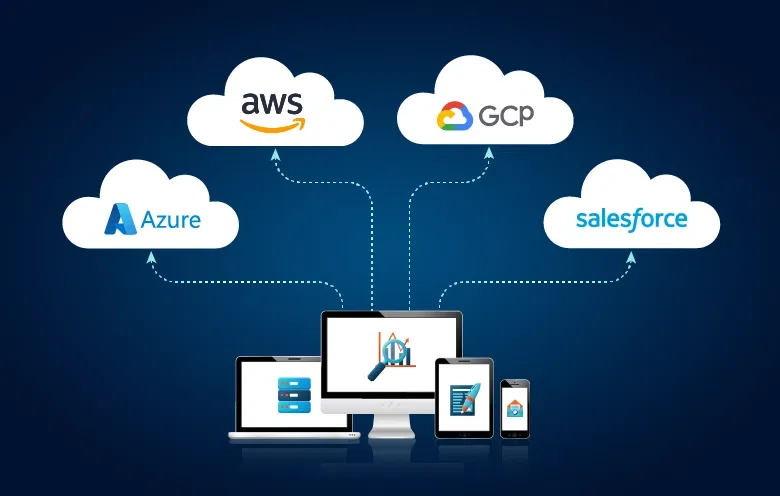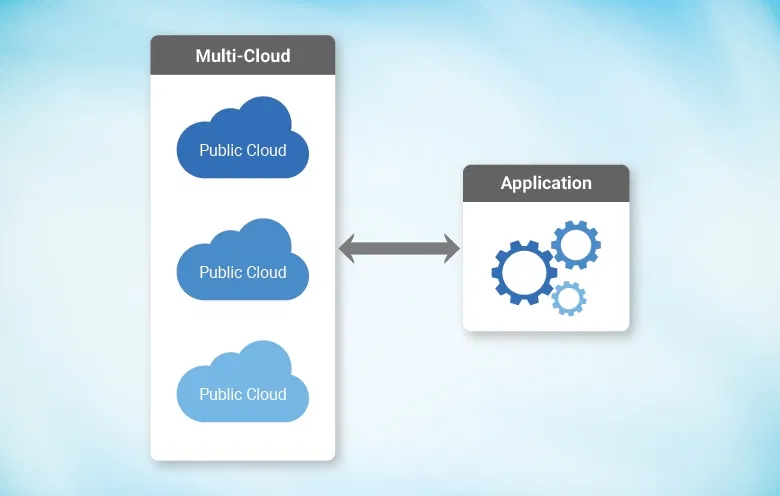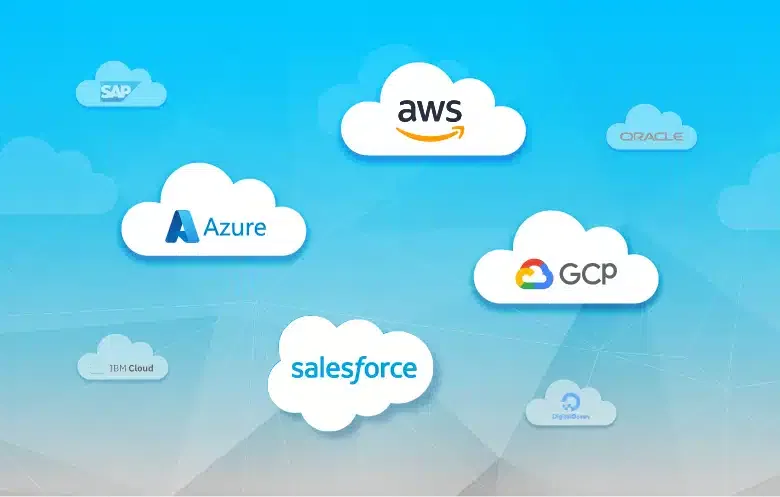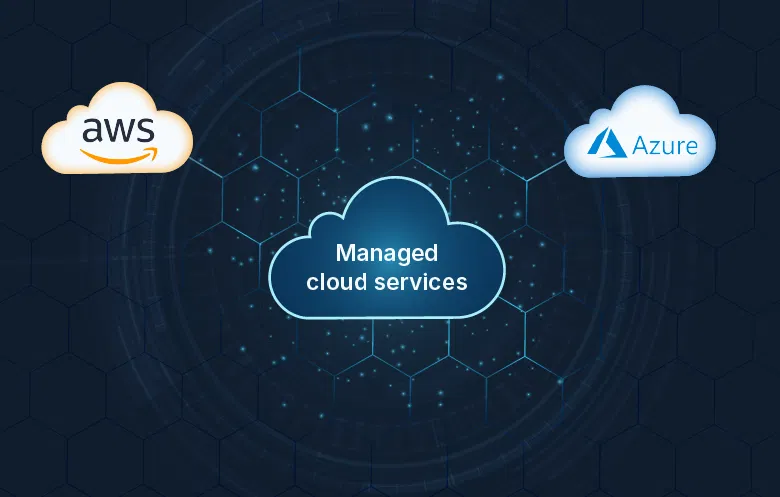Multi-cloud is changing how smart businesses manage growth, compliance, and innovation. It helps enterprises outsmart risks, reduce downtime, and optimize their cloud spending. Multi-cloud gives businesses control, continuity, and choice in a world where disruption is constant. It’s how digital leaders keep their systems powered up.
Dependence on a single cloud provider may restrict flexibility, enhance risk, and make it harder to adapt as your business grows. Just as smart investors diversify their portfolio to manage risk and capitalize on better opportunities, modern enterprises are turning to multi-cloud strategies for better control of their IT systems.
By separating workloads among multiple cloud providers, companies can utilize the strengths of each provider, eliminate single-vendor reliance, and build stronger protection against downtime or security breaches.
This strategic deployment improves performance and enables companies to match workloads with the most appropriate cloud environments. With the help of a multi-managed cloud service provider, organizations can drive faster innovation, scale more efficiently, and respond more effectively to evolving needs. In this blog, we will outline the major benefits of multi-cloud deployment and explore where it provides the greatest value.
Let’s begin by understanding the basic concept of multi-cloud.
What is multi-cloud?
Multi-cloud is a strategy that involves using multiple public cloud services from various providers. Organizations use a mix of on-premises, private cloud, and public cloud, to build, operate, access, and secure their apps consistently across clouds.
This multi-cloud strategy helps them develop, deploy, and run applications with more flexibility and scalability. But it also brings about some complexities in ensuring consistency across the environments. To overcome this challenge, organizations are embracing unified platforms and tools that help them run, access, and secure their applications consistently, irrespective of their location. This guarantees uniform performance, governance, and security across every cloud environment.
Multi-cloud infrastructures provide the agility to deploy workloads on any cloud that the company needs and migrate, manage, and secure applications consistently wherever they are located. These architectures allow businesses to move at speed, spend less, and minimize risk over a dispersed IT environment.
What is a multi-cloud strategy?
A multi-cloud strategy requires two or more public cloud providers such as AWS, Azure, GCP, Salesforce, and more to host applications and store data. This is done to utilize the strengths of various cloud services, maximize costs, and minimize the risk of downtime.
Organizations can choose particular services from various cloud vendors as per their individual capabilities and needs. For instance, they could choose one vendor for the best AI and machine learning capabilities and another vendor for the best data storage capabilities. The idea is to utilize the best of everything that a particular cloud vendor has to offer, thereby making the IT infrastructure stronger and more agile.
Why do businesses need a multi-cloud strategy?
Staying dependent on a single cloud provider can quietly limit your growth in today’s digital economy. A multi-cloud strategy isn’t just about diversification; it’s about designing freedom into your IT architecture.
-
-
Vendor lock-in
-
A multi-cloud setup helps organizations avoid vendor lock-in. Vendor lock-in constrains an organization’s ability to change vendors in case of a need. A multi-cloud setup gives them the flexibility to select cloud solutions that are well-suited to their business needs. They can change providers over performance and cost to optimize their operations.
-
System performance and dependability
A multi-cloud strategy also improves system performance and dependability. By dividing workloads over multiple cloud environments, organizations can attain improved connectivity with low latency and better system performance. This strategy also prevents a failure in one cloud from affecting others, reducing downtime while ensuring business continuity.
-
Data sovereignty and compliance
The multi-cloud strategy facilitates data sovereignty and region-specific regulatory compliance. This is especially crucial for businesses that have global operations, as it allows them to maintain compliance with country-specific data protection regulations and minimize costs efficiently.
Steps for adopting a multi-cloud strategy
Managing multiple clouds requires more than technical setup, it demands proper planning, and alignment across people, processes, and platforms. It is like setting the ground rules for long-term success.
- Goal setting: Identifying goals and problems with current IT infrastructure is important to provide grounds for buying products from cloud vendors. This phase also outlines how success will be tracked, ensuring alignment between technology investments and business outcomes.
- Tool selection: A multi-cloud strategy also provides the option to choose various cloud services from different providers. For instance, one cloud platform may serve high volumes of requests within a specific time, while another cloud platform may serve better for smaller volumes of requests within the same period. Certain cloud providers even provide more big data analytics tools or other specialized features, like machine learning, than others.
- Security and compliance: After installing the necessary tools, an organization should formalize security policies for employees. Additional security practices, such as encryption and multifactor authentication, should be employed as well, depending on laws and regulations relevant to the organization.
- Management: Skilled IT personnel are required when operating in multi-cloud environments. When it is a question of new tools, training must be provided to get staff up to speed.
- Constant monitoring: The last one is to constantly monitor the operation of a multi-cloud environment once it has been deployed.
Multi-cloud use cases
Understanding “why” gets clearer with real-world examples. This section offers perspectives that translate multi-cloud potential into practical, industry-specific solutions. Let these scenarios guide how you apply multi-cloud to your unique business context.
-
Enterprise application deployment
Multi-cloud provides organizations with a choice of deploying application components on the most appropriate clouds for performance, security, and compliance. Geographic spread provides high availability, and workload placement maximizes user experience. An enterprise can deploy some applications on a public cloud for scalability and sensitive data protection on a private cloud.
-
Data storage and management
Multi-cloud facilitates effective data storage through the dispersal of data across clouds for performance and redundancy. It assists businesses in compliance with regulatory needs, cost optimization, and the management of data access according to application requirements. Cloud storage solutions also facilitate easy backup and disaster recovery.
-
Disaster recovery and business continuity
Companies can achieve robustness against outages and loss of data by using several cloud providers. Automatic recovery and failover measures ensure continuity even when one provider fails. This strategy ensures minimal downtime and seamless business continuity.
-
Development and testing environments
Multi-cloud offers isolated, flexible software development and testing environments. It ensures consistent CI/CD pipelines, scalable resources, and cost-effective utilization of public cloud instances. Developers can run application testing in real-world environments prior to full-scale deployment.
-
Big data processing and analytics
Multi-cloud is used by organizations to process large amounts of data effectively using the best analytics offerings from multiple providers. Processing occurs closer to storage sites to save on transfer costs and enhance speed. Scalable cloud resources enable companies to execute intensive AI and machine learning workloads on demand.
7 benefits of multi-cloud strategy
A well-orchestrated multi-cloud strategy pays off in ways that go beyond cost or uptime. Here, we explore how it fuels innovation and vendor neutrality in a fast-moving market. Use this insight to position your cloud model as a growth enabler, not just infrastructure.
1. Select from a variety of best-in-class multi-cloud vendors
Having several clouds implemented in a company’s IT strategy allows administrators to map their business needs with the best cloud hosting services that meet each particular use case.
2. Optimize savings on cloud expenses
Selecting the multi-cloud environments can be an effective way to decrease your IT expenses. Public cloud-based solutions entail lower overhead expenses and offer scalability of resources according to your needs. This helps you lower the Total Cost of Ownership (TCO) while maximizing the optimal balance between price and performance by different vendors.
3. Refrain from vendor lock-in and dependence
As mentioned before, in a multi-cloud setup, you are able to deploy anywhere quickly. Such a method frees you from dependence on one provider and allows you to choose solutions that exactly fit your business needs. This reduces data, interoperability, and cost challenges that often arise from over-reliance on one cloud provider.
4. Ensure strong security and regulatory compliance
A multi-cloud strategy allows you to deploy and scale workloads with consistent implementation of security policies and compliance tools across all your workloads, regardless of service, vendor, or environment.
5. Achieve scalability and flexibility
Multi-cloud solutions create a perfect space for the storage and processing of large volumes of data, with efficient automation and real-time synchronization. In addition to storage, multi-cloud is superior in scalability, where businesses can scale their storage capacity according to changing requirements.
6. Utilize innovation driven technology
By automating the process of multi-cloud management, companies can unify disparate workloads, manage hybrid workflows effectively, and unify DevOps practices to drive innovation. Automation is crucial in orchestrating applications, data, and infrastructure across different cloud infrastructures, expanding deployment capabilities and allowing for rapid delivery of business services.
7. Enhance your company’s sophisticated risk mitigation
Implementing a multi-cloud strategy improves risk management. Where there are problems with infrastructure or security breaches by one cloud provider, multi-cloud users can easily switch to a different provider or back up to a private cloud. Multi-cloud providers eliminate risk by equipping redundant, autonomous systems with strong authentication controls, vulnerability testing, and API asset consolidation.
Overcoming challenges in multi-cloud adoption
Complexity is a side effect of ambition and multi-cloud is no exception. But challenges don’t have to be blockers; they can be signals for smarter design. While multi-cloud provides new capabilities, it also introduces complexity. Recognizing these friction points early can help you mitigate risks before they scale.
-
Complexity in management
Managing multiple cloud environments can be complex, requiring robust cloud management platforms that offer unified control and monitoring. These platforms should provide features like centralized dashboards, automated compliance checks, and performance monitoring to simplify management tasks.
-
Security concerns
In a multi-cloud setup, applying uniform security policies across different cloud providers requires a coordinated approach. This includes leveraging Identity and Access Management (IAM) systems to control user permissions, implementing encryption to safeguard data in transit and at rest, and conducting regular security audits to maintain compliance and detect vulnerabilities.
-
Skilled personnel
A multi-cloud strategy demands skilled IT personnel proficient in managing different cloud platforms. Teams must stay current with evolving technologies, tools, and best practices to effectively support and optimize multi-cloud environments.
Optimized, Innovate, Scale- Embrace multi-cloud today!
Operationalize your multi-cloud strategy for scalable success
Businesses must adopt multi-cloud strategies and operationalize them with discipline to maintain consistent governance, security, and cost control; and foresight to plan for scalability, mitigate risks, and align with long-term business goals. This ensures interoperability across platforms and creates a culture of continuous improvement.
By establishing clear governance, streamlining workload management, and leveraging automation, organizations can unlock the full potential of their multi-cloud environments. This not only minimizes operational complexity but also enhances agility, compliance, and cost efficiency. Talk to our cloud experts to learn how the multi-cloud strategy can contribute to the development of your business.




